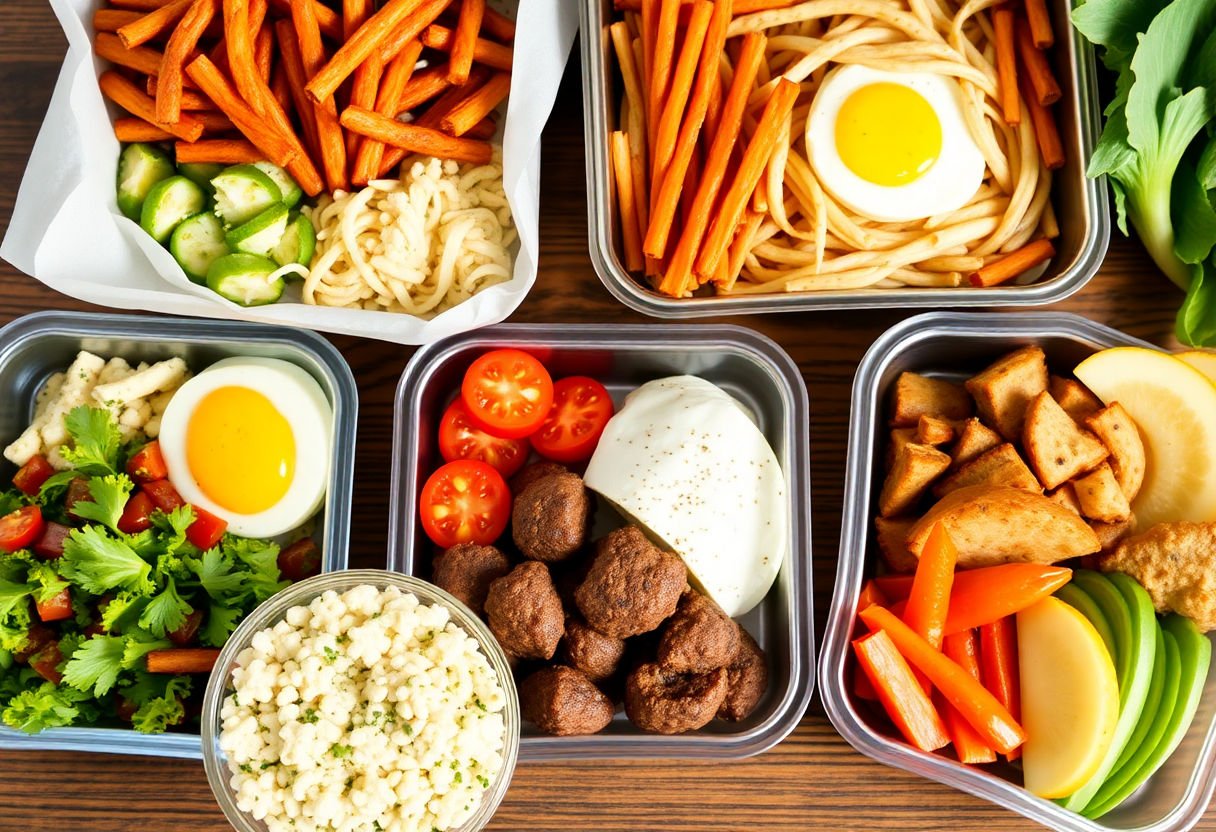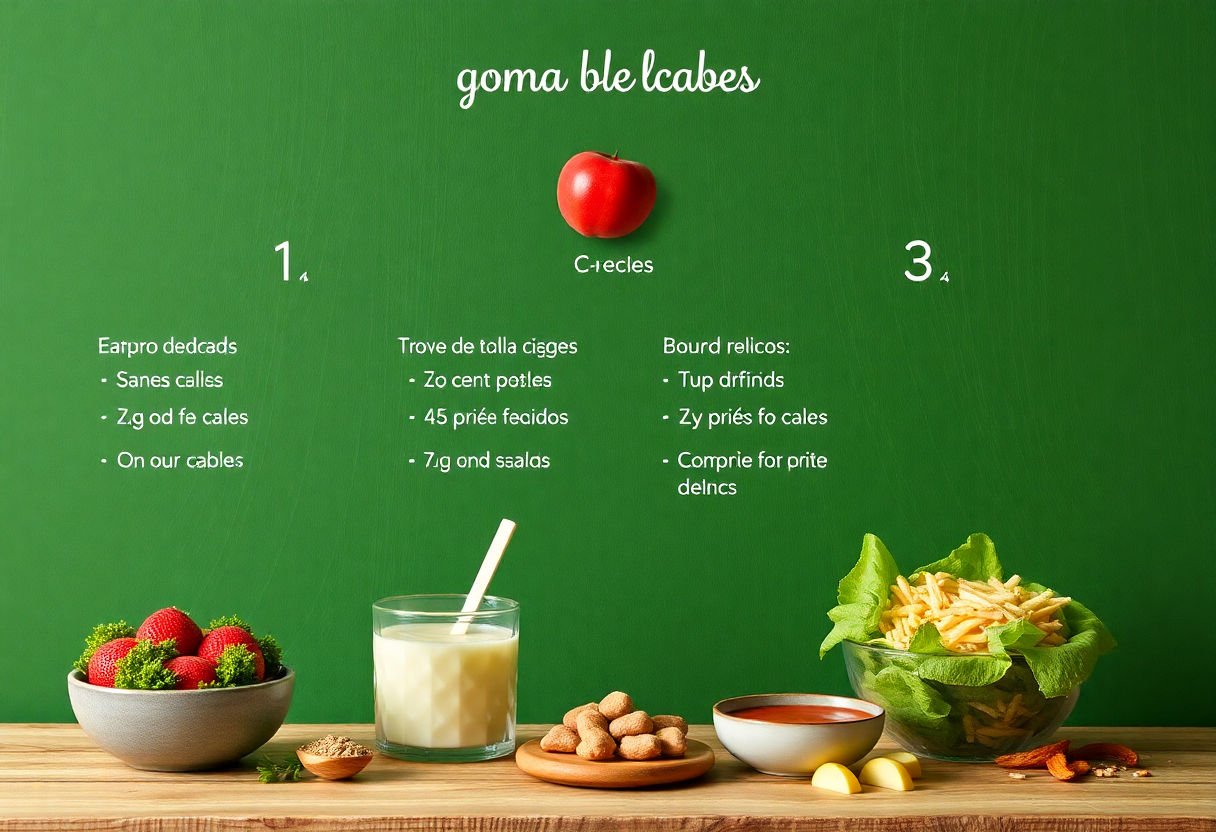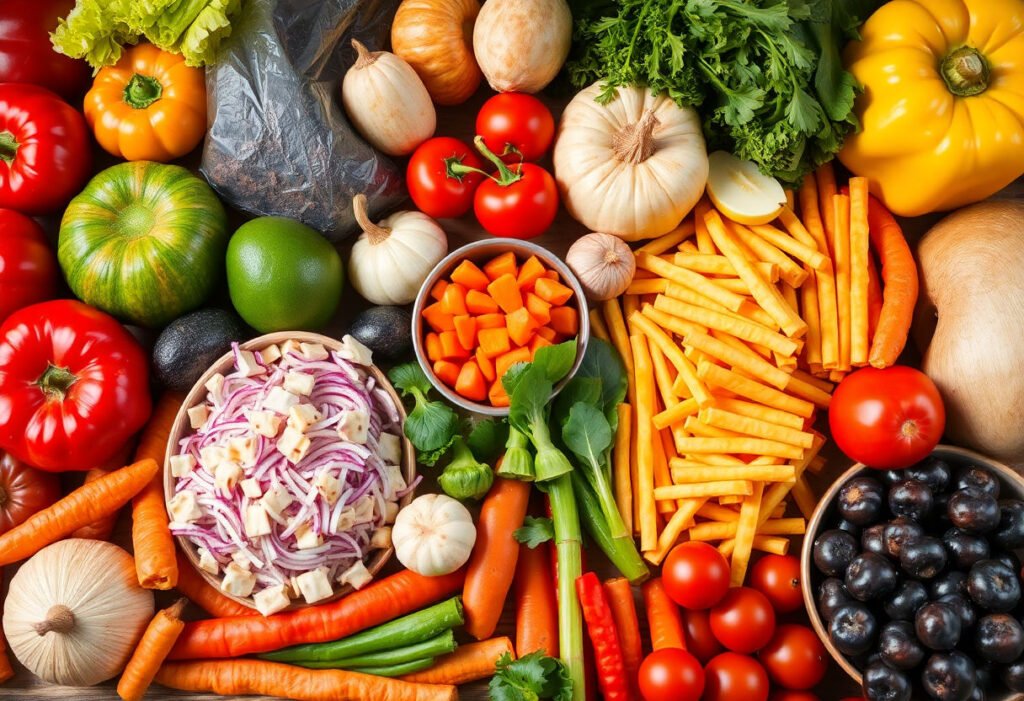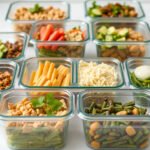Embracing whole foods meal prep is a transformative journey toward a healthier lifestyle. By focusing on natural, minimally processed ingredients, this guide will equip you with the knowledge to efficiently plan, prepare, and store nutritious meals. Discover the health benefits, explore a variety of essential ingredients, and utilize practical tools and strategies to streamline your meal prep process. Whether aiming to save time, reduce costs, or tailor meals to dietary needs, this comprehensive guide is designed to empower you to create balanced, delicious meals that cater to your nutrition goals—all while simplifying your daily routine.
Key Takeaways
- Whole foods meal prep promotes a healthier lifestyle by focusing on nutrient-dense, minimally processed ingredients.
- Planning meals ahead reduces time and financial stress, allowing for well-balanced dietary habits.
- Essential tools and staple ingredients streamline the preparation process, enhancing efficiency and effectiveness.
- Adhering to proper storage techniques maintains food quality, ensuring meals remain fresh throughout the week.
- Customizing meal prep plans accommodates dietary needs and preferences, providing flexibility and personal satisfaction.
Benefits of Whole Foods Meal Prep

Whole foods meal prep offers numerous benefits that resonate across health, time-saving, and financial dimensions. By focusing on natural, unprocessed ingredients, individuals unlock the potential for a healthier lifestyle. Studies have shown that diets rich in whole foods are linked to lower risks of chronic diseases such as heart disease, diabetes, and obesity.
Health Benefits
One of the primary advantages of whole foods meal prep is its direct impact on health. Whole foods, such as fresh fruits, vegetables, whole grains, and lean proteins, are packed with essential nutrients and fiber that promote optimal body function. Consuming these foods regularly can boost the immune system, enhance digestive health, and improve energy levels. Additionally, whole foods are often free from artificial additives and preservatives, reducing the risk of toxic buildup in the body.
Time-Saving Advantages
Meal prepping with whole foods can significantly reduce the time spent on daily food preparations. By dedicating a few hours weekly to prepare meals ahead, individuals can enjoy more leisure time throughout the week. This organized approach not only simplifies meal times but also reduces the stress associated with last-minute cooking.
Financial Benefits
Whole foods meal prep is economically beneficial. Purchasing ingredients in bulk and preparing meals in advance can lead to substantial grocery savings. Moreover, reducing reliance on processed and convenience foods helps cut down on unnecessary spending. As author Michael Pollan aptly puts it, “The more you spend on ingredients, the less you need to spend on healthcare.”
Incorporating whole foods meal prep into your lifestyle offers a holistic approach to achieving better health, efficiency, and financial stability. This strategy empowers individuals to take charge of their dietary habits while reaping long-term benefits.
Essential Ingredients for Whole Foods

Whole foods meal prep relies on having a variety of nutritious ingredients readily available. Stocking your pantry and refrigerator with these essentials will not only streamline your meal preparation process but also ensure you’re poised to create balanced, flavorful dishes.
Whole Grains: Incorporate grains like quinoa, brown rice, and oats into your meals. These fiber-rich staples offer versatility and are foundational for many dishes, providing sustained energy throughout the day.
Fruits and Vegetables: Fresh produce is at the heart of whole foods. Aim for a diverse array of fruits and vegetables, prioritizing locally sourced, seasonal options for peak freshness and taste. Leafy greens, like spinach and kale, and colorful choices, such as bell peppers and berries, are excellent inclusions.
Legumes and Lentils: Beans, chickpeas, and lentils are not only affordable but also high in protein and fiber. They can be seamlessly integrated into salads, soups, and main courses, enhancing both nutrition and satiety.
Nuts and Seeds: Almonds, walnuts, flaxseeds, and chia seeds are nutrient-dense choices providing healthy fats, proteins, and essential minerals. They’re perfect for snacks or as toppings on oatmeal and salads.
Lean Proteins: While plant-based proteins are emphasized, lean meats and poultry, along with sustainably sourced fish, offer high-quality protein and omega-3 fatty acids, making them invaluable components of a whole foods diet.
Herbs and Spices: Fresh herbs like basil and cilantro, along with spices such as cumin and turmeric, are crucial for adding flavor without excess sodium or calories. Keeping a well-rounded collection can transform simple dishes into culinary delights.
By keeping these essential ingredients on hand, you set the stage for an efficient and effective whole foods meal prep routine, ensuring each meal is as nutritious as it is delicious.
Basic Tools for Meal Prep Success
To master whole foods meal prep, equipping your kitchen with essential tools can significantly streamline the prepping process. These tools not only enhance efficiency but also ensure that the quality of your meals remains high.
Cooking utensils form the foundation of any meal prep routine. Invest in a diverse set of knives, emphasizing a chef’s knife for chopping and a paring knife for intricate work. A sturdy cutting board, preferably one that is nonslip, will be indispensable for safe and efficient vegetable slicing.
High-quality cookware is another pillar of successful meal preparation. Non-stick pans, durable pots, and a reliable baking sheet are fundamental for cooking a variety of whole foods. For steaming vegetables or grains, consider a versatile skillet or a steamer basket that retains nutrients better than boiling.
For storage and organization, invest in airtight containers of various sizes, which are essential for keeping prepped ingredients fresh and within easy reach. Glass containers are preferred for their absence of harmful chemicals and ability to withstand temperature changes.
Kitchen appliances such as a food processor and blender can drastically reduce prep time by swiftly chopping, blending, and pureeing ingredients. A slow cooker or an Instant Pot offers the added benefit of “set and forget” cooking, allowing you to prepare meals in advance with minimal effort.
Lastly, a comprehensive set of measuring cups and spoons ensures precision in portion sizes and nutrients, especially advantageous when preparing balanced meals designed to meet specific dietary requirements. By investing in these basic tools, meal prep becomes not only simpler but also more enjoyable.
Planning Your Whole Foods Meal Prep Schedule
Planning your whole foods meal prep schedule is a critical step toward achieving culinary efficiency and dietary success. Start by assessing your week—understand your work hours, social commitments, and any other activities that might influence your schedule. Having a clear view of your week allows you to allocate specific slots for meal preparation, ensuring you make the most of your time.
Next, develop a meal plan that caters to your individual needs and preferences. Identify staple recipes and ingredients that you enjoy and feel confident preparing. Incorporate a variety of proteins, grains, and vegetables to create balanced meals while maintaining interest throughout the week. “Meal prep is far less daunting when you embrace variety,” says nutrition expert Jane Smith.
When planning your shopping list, focus on ingredients that are versatile and can be used across multiple dishes. This not only simplifies meal prep but also reduces potential waste. Invest in airtight containers of varying sizes to keep your prepped meals fresh and organized.
Consider preparing meals in batches, such as making double portions of a hearty stew or a grain salad that can be repurposed into different dishes. This batch cooking approach significantly reduces time spent in the kitchen.
Lastly, ensure that your meal schedule includes time for cooking as well as portions for rest and enjoyment. By establishing a rhythm, you’ll find meal prepping to be a harmonious and beneficial part of your weekly routine.
Creating Balanced Whole Foods Meals
Creating balanced whole foods meals is an essential aspect of mastering meal prep with a focus on nutrition and variety. Achieving this balance involves a combination of macronutrients, micronutrients, and dietary fibers, all sourced from unprocessed or minimally processed ingredients.
Begin by ensuring adequate portions of macronutrients in every meal:
-
Proteins: Include plant-based and lean animal proteins such as beans, lentils, quinoa, chicken, or fish to support muscle maintenance and repair.
-
Carbohydrates: Opt for complex carbohydrates, like whole grains, oats, sweet potatoes, and brown rice, which provide sustained energy.
-
Fats: Incorporate healthy fats from sources like avocados, nuts, seeds, and olive oil to enhance nutrient absorption and support cellular functions.
Equally vital is the inclusion of micronutrients from diverse food groups:
-
Vegetables and Fruits: Aim for a spectrum of colorful fruits and vegetables to ensure a wide range of vitamins, minerals, and antioxidants. Strive to fill half of your plate with these plant-based foods.
-
Nuts and Seeds: These not only contribute healthy fats but also provide essential minerals such as magnesium and zinc.
Mindful portion control is crucial to ensure meals are not only balanced but also suitable for individual dietary needs. Use measuring tools to maintain appropriate serving sizes and avoid overeating.
Strive for meal variety to prevent palate fatigue. Rotate proteins, grains, and seasonal vegetables throughout the week to keep meals exciting and nutritious. Planning meals with an awareness of nutritional balance can significantly enhance overall health and well-being.
Time-Saving Meal Prep Strategies
Maximizing efficiency in the kitchen while maintaining quality and variety in whole foods meal prep is essential. Here are some effective strategies that can save time and still deliver delicious results:
-
Batch Cooking and Freezing: Prepare large batches of versatile staples, such as grains, legumes, and sauces. Portion and freeze these items in airtight containers. This not only reduces cooking time throughout the week but also ensures you always have a base for quick meals.
-
Pre-Wash and Pre-Cut Ingredients: Spend a portion of your prep time washing and chopping vegetables and fruits. Store them in clear containers to easily access when assembling meals. This practice simplifies cooking and minimizes cleanup efforts during the week.
-
Utilize Slow Cookers and Instant Pots: Set it and forget it with these appliances. They require minimal supervision, allowing you to multitask. Stews, soups, and even whole grains can be effortlessly prepared while you attend to other duties.
-
Embrace One-Pan or One-Pot Meals: These recipes are time-savers as they require fewer dishes and often take less time to cook. They ensure that flavors meld together, creating rich, satisfying meals with minimal effort.
-
Create Ingredient Themes for the Week: Focus on a specific set of ingredients for variety in dishes. For example, if you buy a large batch of spinach, plan dishes like spinach salads, smoothies, and stir-fries. This drastically reduces decision fatigue while ensuring no ingredients go to waste.
By integrating these strategies into your meal prep routine, you streamline the process while enhancing the quality and nutritional value of your meals.
Proper Storage Techniques for Longevity

Storing prepped whole foods correctly is essential to maintain their freshness and extend their lifespan, ensuring that meals remain safe and enjoyable to eat. Here are key techniques that should be a part of any whole foods meal prep routine:
-
Temperature Control: Maintaining the right temperature is crucial. Refrigerate perishable foods promptly at or below 40°F. For long-term storage, freezing should be done at 0°F or lower. It’s advisable to cool hot foods before refrigeration to prevent raising the fridge’s internal temperature.
-
Proper Containers: Use airtight containers to lock in freshness and prevent contamination. Glass containers are ideal as they don’t leach chemicals and are environment-friendly. For dry goods like grains and nuts, consider using mason jars or vacuum-sealed bags.
-
Labeling and Dating: Clearly label all containers with the contents and the date they were prepared. This practice not only aids in meal management but also helps to avoid consuming food past its prime, reducing waste.
-
Optimal Shelving: Store foods based on their shelf life; place items that need to be consumed sooner at the front. In refrigerators, use the top shelves for ready-to-eat meals, middle for dairy and eggs, and bottom for raw meats to prevent cross-contamination.
-
Batch Cooking and Portioning: Prepare meals in bulk but portion them before storage to reduce multiple thawing/refreezing cycles, which can degrade food quality. Pack individual servings, which can be quickly reheated, thereby saving time and preserving taste.
Employing these storage techniques not only enhances the longevity of whole foods but also maximizes the nutritional value of your meal preps, ensuring consistent healthy eating.
Adapting to Dietary Needs and Preferences

When embarking on a whole foods meal prep journey, it’s essential to tailor your plans to accommodate various dietary needs and preferences. Adapting your meal prep strategy ensures that you can maintain a consistent, enjoyable routine that aligns with your personal health goals.
Navigating Dietary Restrictions
Whether you’re gluten-free, lactose intolerant, or following a plant-based diet, it’s crucial to identify whole foods that suit these dietary requirements. For instance, those avoiding gluten can rely on quinoa, sweet potatoes, and rice as nutrient-rich, filling alternatives to wheat-based products. Similarly, coconut or almond milk often substitutes for dairy, providing versatility in preparing meals without sacrificing nutrition.
Personal Flavor Preferences
Meal prep becomes significantly more sustainable when it aligns with your flavor preferences. Experiment with a diverse range of herbs and spices to enhance the taste of whole foods, making your meals both nutritious and satisfying. Personalizing meals will motivate you to stick to your prepared plans and reduce the temptation to opt for less healthy alternatives.
Incorporating Family and Cultural Preferences
When preparing meals for families or groups, it’s crucial to consider everyone’s tastes and cultural food practices. This might mean integrating traditional dishes or ingredients that carry cultural significance. By doing so, you ensure that the meal prep process is inclusive and celebrates diversity, promoting a more harmonious dining experience for all involved.
By considering dietary needs, personal preferences, and cultural practices, you can create a whole foods meal prep routine that is not only sustainable but also enriching and enjoyable for everyone involved.
Conclusion
Embarking on or enhancing your whole foods meal prep journey promises significant benefits for both health and lifestyle. As highlighted, preparing meals with whole foods is not only a boon to your wellness but also an efficient way to save time and money. By integrating essential ingredients and tools, tailoring plans to your needs, and implementing effective storage techniques, you can ensure a consistent supply of nutritious meals. As you refine your meal prep strategies, aim to accommodate dietary preferences and restrictions, paving the way for a sustainable and tailored approach to healthy eating.
Frequently Asked Questions
What is whole foods meal prep?
Whole foods meal prep involves preparing meals using minimally processed foods, such as fruits, vegetables, whole grains, and lean proteins. This method emphasizes freshness and nutritional value, helping individuals maintain a healthy diet.
How do I start meal prepping with whole foods?
Begin by planning your meals for the week, focusing on simple recipes that incorporate a variety of whole foods. Purchase your groceries, prepare ingredients in advance, and store them appropriately to ensure freshness and convenience.
What are the health benefits of whole foods meal prep?
Whole foods meal prep supports a balanced diet rich in nutrients, which can lead to improved energy levels, enhanced digestion, and a reduced risk of chronic diseases. This approach can also help maintain healthy weight management.
How can I ensure my prepped meals stay fresh?
Use airtight containers and store meals in the refrigerator or freezer, depending on how soon you plan to consume them. Proper portioning and labeling can help you track food freshness and avoid spoilage.
Can whole foods meal prep save me money?
By planning meals ahead and buying ingredients in bulk, you can minimize food waste and save money on groceries. This method ensures you only purchase what is necessary, reducing the need for takeout or last-minute shopping trips.


